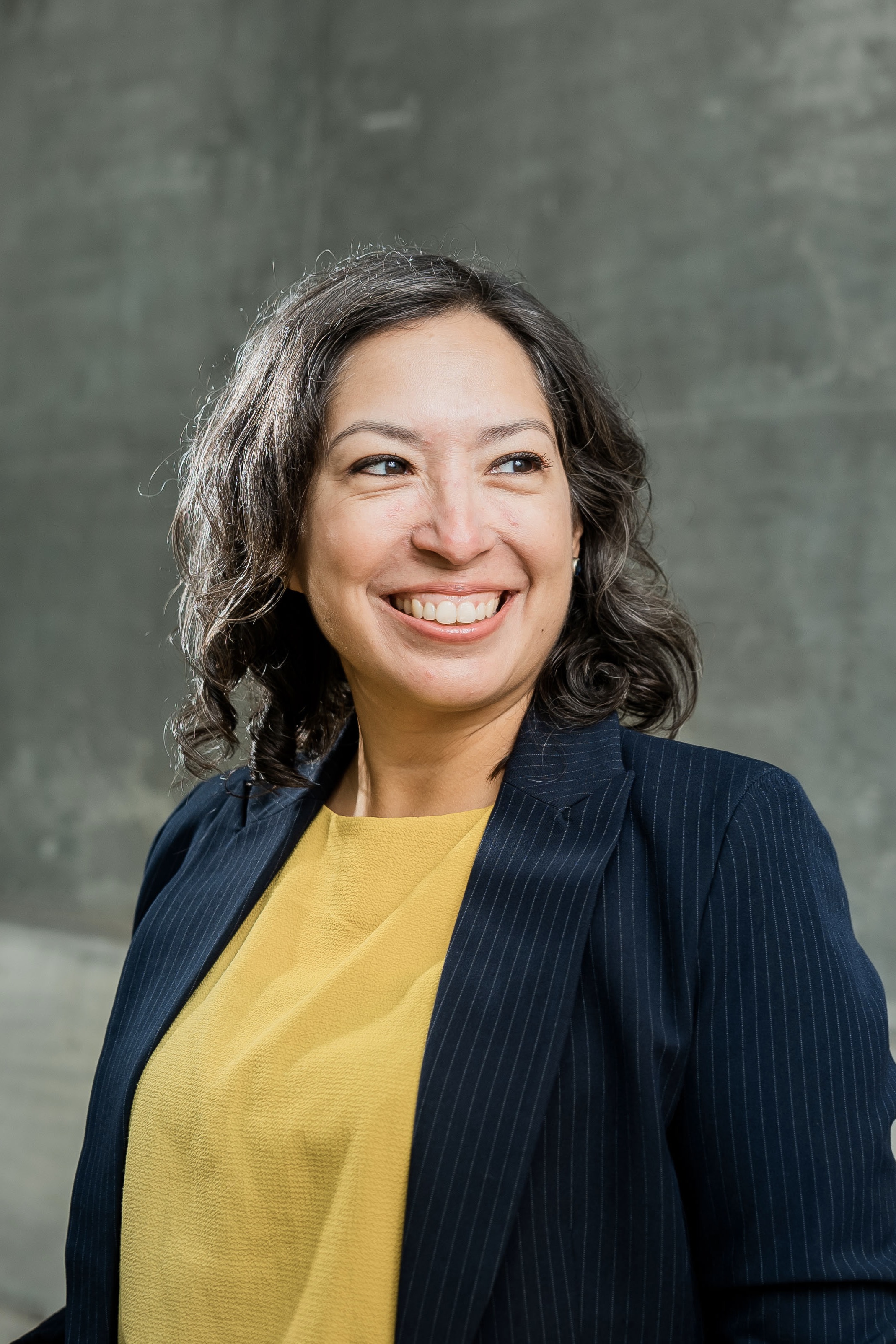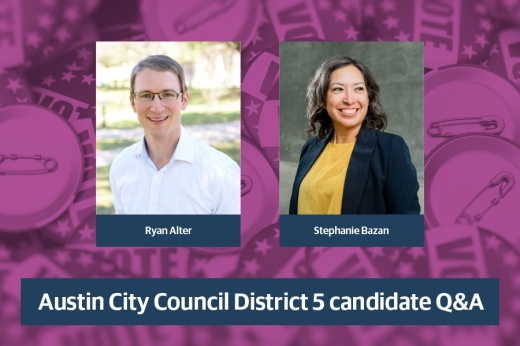Alter and Bazan emerged from a six-person general election field after each earned more than 20% of the local vote; 9,600 District 5 voters selected Bazan, and 7,933 voted for Alter in November. The two were among the candidates with the most political donations and spending in the race and beat out lead fundraiser Aaron Velazquez Webman as well as Ken Craig, policy adviser for current District 5 Council Member Ann Kitchen.
The winner of District 5's runoff will replace Kitchen and start their four-year term in January.
Early voting for the runoff election will run from Dec. 1-9, and election day is Dec. 13. More information on voting, including locations and hours of polling places, is available through the Travis County clerk's website.

Ryan Alter
Experience:
Senior policy analyst, state Sen. Kirk Watson; general counsel, state Sen. Juan Hinojosa; policy analyst, state Sen. Sylvia Garcia; staff attorney, Judge Karin Crump; owner, small business building attainable missing middle housing
Occupation:
Attorney
Candidate Website:
https://www.ryanforatx.com/
How safe do you believe Austin is today? Do you think any funding, staffing or operational changes are needed in the city’s public safety departments?
Austin is a safe city for many, but should be safe for everyone. Everyone should feel comfortable walking around their neighborhood, enjoying an evening out around town, and interacting with law enforcement. This can be a reality if we move past the old way of thinking and instead approach public safety holistically. Council needs to establish what responsibilities are the most appropriate for our public safety departments and ensure adequate resources are provided for that response to be effective. There are numerous situations that not only do not require police responses, but would actually result in better outcomes for the public if other professionals are utilized. For instance, we know mental health emergencies are best suited for an entity like EMS, yet many of these calls still end up with APD. Similarly, victims of sexual assault can be retraumatized when interacting with law enforcement and would be better served by another agency. We can design a comprehensive public safety system that makes Austin safer and more prosperous if we are willing. Everyone should feel free to enjoy all that Austin has to offer, and that’s what I intend to do.
How do you believe city resources should be used to address homelessness? What do you see as the most effective policy options to get people services and housing?
We have not done enough to help our unhoused neighbors. We need a more robust effort that addresses this challenge at the scale that is needed. At the heart of this issue are human beings who deserve to have a bed to sleep in, a roof over their head, and a place to call home. The city does have a big plan to create thousands of units for the unhoused, with a large portion of those being critical permanent supportive housing. I would like to see us execute this plan on time or early and remember that this plan does not solve the problem. We have to make sustained investments in permanent housing beyond Finding Home ATX, and I would advocate for such in our future budgets. We should also establish regional stabilization hubs that provide a safe space to live and receive necessary services like physical and mental health, transportation, sanitation, and case working, which will then serve as the bridge to the housing we have in the pipeline.
What challenges or needs related to the overall city budget and property tax rate do you anticipate facing during your term? What fiscal strategies would you bring to the table to address those?
A budget is a moral document and reflects our values as a city. When crafting our budget, we must first provide the necessary resources to ensure we are excelling at providing our core services. It is equally important to include proper accountability metrics that ensure the money we are spending is money well spent. It is then essential that we invest in programs that invest in our people, from public health, to clean outdoor spaces, to enriching our cultural diversity. This must all be done while remembering that we are in an affordability crisis. It is our duty to remember that it is real people and small businesses that pay for these programs, and we should do all that we can to provide robust effective services while keeping the overall tax bill for our people as low as possible so they can continue to enjoy the many things they helped pay to create.
What aspects of the city’s land development code, if any, would you propose to review? How do you believe council should handle Austin’s ongoing growth and its existing neighborhoods, from individual zoning cases to broader policy updates?
The biggest thing we can do to make Austin more affordable is update the Land Development Code to allow for housing opportunities for everyone everywhere. Our code is older than I am and dictates building large expensive homes that few can afford. Austin is a different city than it was 40 years ago, and it is time we updated our code to ask not what Austin used to be, but rather what do we want Austin to be decades from now. This should be paired with immediate action that will create the diversity of housing we need throughout Austin. My Housing Now plan contains a series of policies that would do this. A major component of this plan is Opportunity Unlocked, which will create more housing at levels that are affordable for a majority of Austinites. This will not only create more opportunities for everyday residents, but it will also lessen the pressure on low-income housing. Currently, many people looking for middle-income housing simply cannot find it, because it doesn’t exist. This forces them to overbid on homes that are less expensive and price out those who can only afford these less-expensive options. This persists down the income ladder and eventually squeezes out those at the bottom. By creating more missing middle housing, as my Housing Now plan does, we can take that pressure off the lower- priced homes and finally create housing for everyone everywhere.
How should council address the implementation of larger transportation initiatives including the I-35 expansion and Project Connect? What safety and mobility improvements would you propose for city roadways and bike/pedestrian routes?
We have failed to keep up with our transportation infrastructure for too long and it shows. Imagine enjoying your commute and not worrying about sitting in traffic. This is possible if we prioritize policies that create options for people to get around the city in an efficient manner, using a multitude of transportation options. This starts with Project Connect and delivering the promise we made to the voters. Austinites asked for a robust transportation system and we must deliver it. This means not getting bogged down in the usual fights or failing to coordinate with the other agencies involved. It also means fulfilling our promise to protect our residents at risk of displacement through a revolutionary fund dedicated to this purpose. Another large investment we are going to be making in transportation is along I-35. If we are going to invest billions of dollars into I-35, the end product has to be something that makes us better off than we are today and that advances our values. We must push for real solutions that support our investments in multimodal transportation; lower emissions for our region; and undo the nearly 100 years of racism that this road has literally cemented into our community. But we must also remember that transportation issues don’t exist in a vacuum. If we make housing available for everyone everywhere, we will allow more people to live near their place of work/study. This will ease the stress on our already congested roadways by making walking/biking a real option or simply replacing the need to drive across town with a short trip. Through smart transportation investments and robust housing policies that support them, we can connect all our residents and finally end the headaches of traveling around Austin.

Stephanie Bazan
Experience:
Crisis advisor and communications professional; experience in education, health care, law and homeless services; LBJ Women's Campaign School at the University of Texas School of Public Affairs; Moms Demand Action member; Austin Community Foundation Hispanic Impact Fund steering committee member; The Junior League of Austin board member; GAHCC Hispanic Austin Leadership program leader; Census 2020 digital organizer; has worked closely with elected officials, board members, business owners, committee members and other community leaders
Occupation:
Crisis advisor and chief communications officer
Candidate Website:
https://stephaniebazan.com/
Contact Information:
737-298-7836
How safe do you believe Austin is today? Do you think any funding, staffing or operational changes are needed in the city’s public safety departments?
There is opportunity for improvement. As Austin grows and changes, so must our public safety services to better provide for residents. So far in 2022, crimes against property and crimes against persons are both down relative to 2021, according to the latest crime report. That being said, we can always strive to be a safer city. We need to expand our efforts to recruit and retain diverse and culturally competent public safety staff, ensure that people are paid their worth and also hold leadership accountable. We must also alter certain procedures to encourage protection, de-escalation and community service over strict policing. We need to acknowledge that EMS provides healthcare as a core component of their services and fund appropriately. Continuing education on implicit bias is also key to safer communities. To achieve more quality public safety services we must have greater transparency, accountability and community partnership.
How do you believe city resources should be used to address homelessness? What do you see as the most effective policy options to get people services and housing?
I am a proponent of the Housing First model. It is critical that people experiencing homelessness are able to have permanent housing along with support services. More housing is the solution to the unhoused. How would we get more housing? Through establishment of win/win partnerships with local businesses which has been shown to work. We would also need to partner with proven nonprofits. To make lasting change, we must increase the pace of units for the unhoused and vulnerable and prioritize supportive services along with housing. We should better support and coordinate organizations providing services to those experiencing homelessness and, importantly, work to intervene sooner for those who are housing insecure, so they do not go from homes to the streets. Due to an unforeseen circumstance someone can quickly find themselves on the verge of homelessness. For a person working paycheck to paycheck, damage to their car that they can’t afford to repair can prevent them from getting to work or performing their job if it involves driving. There are many examples of sudden hardships that can upend a person’s already tight budget. We need Emergency Aid. We do have community organizations that have aid, but often it is for current clients and waiting lists are long so those groups do not necessarily help someone in an emergency. The average costs for housing and transportation in Austin make up approximately 47% of household income and as a city we need to scale our resources to include more for homelessness prevention. Although homelessness is a city-wide issue, it is a topic that comes up frequently in D5 due to the camps in our area parks and preserves. What is unique for District 5 is that Sunrise Navigation Center, a nonprofit that serves thousands of people experiencing homelessness each month is in South Austin and they offer a few resources currently not available elsewhere in Austin. They are the only operation where the unhoused can store medication and they also have Texas’ first free Narcan vending machine. They are addressing homelessness in innovative ways, such as through their hotline that will fully launch in October. Austin can strategically replicate some of the things they are doing to relieve pressures from that facility. When I speak to community members they want to be able to do something and now they can submit an Outreach Request Form to a mobile team when they see someone who is experiencing homelessness and may need additional care and support. We need to better communicate these opportunities to the public.
What challenges or needs related to the overall city budget and property tax rate do you anticipate facing during your term? What fiscal strategies would you bring to the table to address those?
The vast majority of a homeowners’ property taxes are school district and County based. We need to use our platform to advocate for our city at the state level to help address recapture. A challenge is that state-imposed revenue caps mean that increased funding in one area generally has to come from another area. I do not commit to increasing funding for just any program, but only those that are efficient and effective at achieving the goals established by the city.
What aspects of the city’s land development code, if any, would you propose to review? How do you believe council should handle Austin’s ongoing growth and its existing neighborhoods, from individual zoning cases to broader policy updates?
Austin needs a diversity of housing throughout the city and rules that allow for it. We cannot accept continuing patterns. We need market rate and subsidized housing construction goals that consider growing demand and that can be realistically met. We need more density on corridors and rules that allow for our city’s growing needs for housing. Austin’s urban planning was deliberately founded in exclusionary zoning. We need land use rules that everyone can understand so we can construct with certainty and build the city we want for our future. I don’t want to get rid of what people love about their neighborhoods, I want to purposefully enhance our neighborhoods, ensure we are welcoming, and make sure that people who live here can afford to stay. We need to streamline the permitting process and address compatibility standards and parking minimums that are not serving us.
How should council address the implementation of larger transportation initiatives including the I-35 expansion and Project Connect? What safety and mobility improvements would you propose for city roadways and bike/pedestrian routes?
Everyone should have access to quality public transportation that is reliable, comprehensive and sustainable. We must ensure that Project Connect is implemented equitably and completed on time and on budget to meet community expectations. I would encourage continued efforts like ATX Walk Bike Roll that contribute to helping people get around more easily. I would champion ongoing collaboration so that transit riders can count on transport with good frequency that reaches their desired destination within a reasonable time. We should support Vision Zero policies to make our streets safer. Safe bus shelters, shaded walkways and other measures should also be considered so we take advantage of transit. While looking at projects that the City has more control over, we need to build new infrastructure that will encourage more modes of transit for Austinites. For I-35, there is countless data to show that more lanes does not equal better. I agree with those on council who have already noted that we should go no wider and no higher. We need to see that Austin residents have a voice within the conversations regarding the I-35 expansion to make sure that the plans are inclusive to our needs as a city and not just a project to help those outside the city get through Austin. It should not be controversial that most of Austin’s growth should be transit accessible. Improved transit and affordable transit-oriented development not only help us with our climate goals, but also with our affordability challenges by driving down the cost of living.





